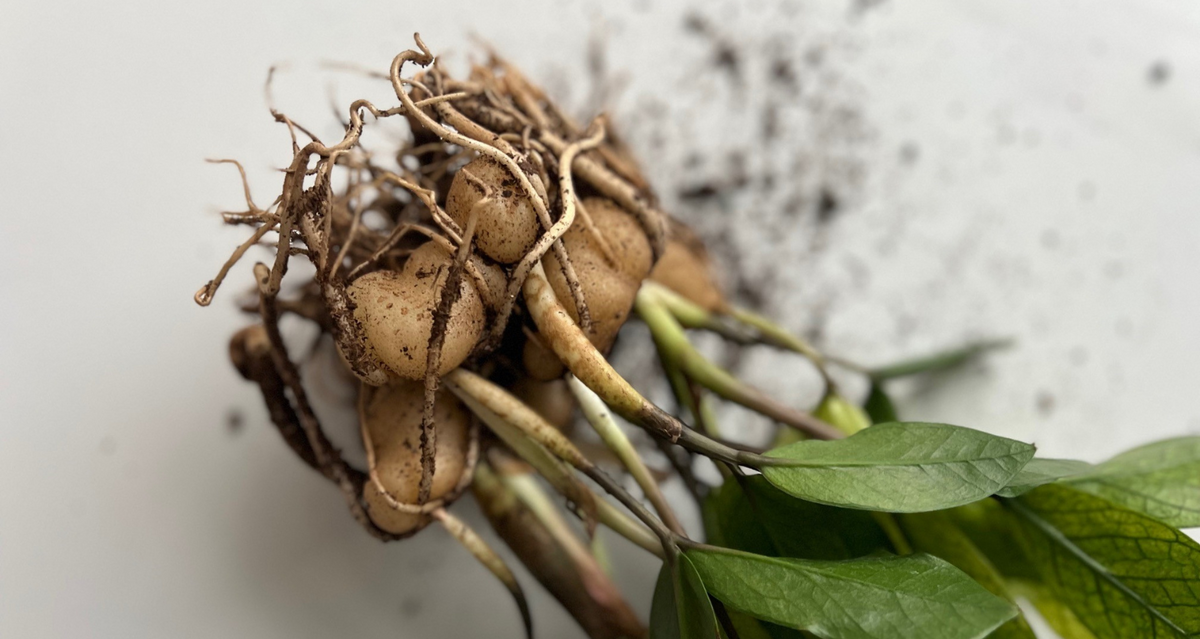
All About Root Rot: A Guide to Symptoms and Solutions
|
Time to read 4 min
|
Time to read 4 min
Root rot, the sneaky saboteur of the plant world, can turn your thriving urban jungle into a wilting nightmare. This insidious condition can strike indoor and outdoor plants, often causing severe damage if left unaddressed. In this blog, we'll explore the causes, symptoms, and practical solutions to combat root rot and ensure your houseplants thrive. If you suspect you're dealing with root rot, the final section of the blog outlines the 4-Step Guide for Managing Root Rot.
Root rot is a fungal disease caused by pathogens that thrive in overly wet or poorly drained soil. When soil is wet, the roots are deprived of the essential oxygen required for optimal functioning. Consequently, this creates an environment conducive to the growth of fungal diseases, which can target a plant's root system, leading to a decline in its capacity to uptake water and nutrients. This leads to wilting, yellowing leaves, and an overall decline in plant health.
Overwatering: Excess water in the soil creates an ideal environment for fungal pathogens to thrive.
Poor Drainage in Soil: Soil that doesn't drain well can trap water around the roots, promoting fungal growth.
Poor Drainage in Pots: Pots that don’t have adequate drainage can easily drown the roots depriving them of oxygen.
Using Contaminated Soil: Using soil already contaminated with the root rot pathogen can introduce the disease to healthy plants.
Crowded Roots: Plants overcrowded in pots or planting beds can lead to poor air circulation and increased moisture, creating the perfect condition for root rot.
Overwatering is watering your plants frequently without allowing the substrate to dry out. Overwatering is NOT watering your plants with a lot of water.
SYMPTOMS OF ROOT ROT:
Wilting and Yellowing Leaves: One of the earliest root rot signs is a large amount of yellowing and wilting of leaves, even when the plant is properly watered.
Drooping and Weak Stems: Infected plants often exhibit drooping and weak stems, unable to support their own weight.
Stunted Growth: Plants affected by root rot may experience slowed or stunted growth, with reduced foliage and smaller leaves.
Foul Odor: A musty, foul root rot smell may emanate from the soil, indicating the presence of fungal activity.
Brown or Blackened Roots: As the disease progresses, the roots may turn brown or black, become mushy, and detach easily from the plant.
EFFECTIVE TREATMENT:
Adjust Watering Practices: Allow the top inch or two of soil to dry out before watering again. Ensure that the pots or planting beds have proper drainage and aren’t sitting in water.
Hydrogen Peroxide: There are two root rot treatment methods involving the use of hydrogen peroxide. The first method entails a peroxide soak, where you immerse the cleaned roots in an 80:20 water to hydrogen peroxide solution for 5 minutes. Subsequently, repot the plant as usual. Alternatively, after repotting the plant in sterile soil, you can water it using a solution of 1 part 3% hydrogen peroxide and 2 parts water. It's important to note that these methods SHOULD NOT be combined simultaneously.
Improve Soil Drainage: Amend heavy or compacted soil with perlite, vermiculite, or coarse sand to improve drainage.
Choose Well-Draining Containers: Use pots with drainage holes to prevent water from accumulating around the roots.
Good Quality Soil: When repotting, use fresh, sterile potting mix to prevent introducing pathogens to healthy plants.
Prune Affected Roots: Carefully remove and prune affected roots, sterilizing your tools between cuts to prevent further spread.
Use Fungicides: In severe cases, consider using natural fungicide for root rot. The benzimidazole fungicides such as thiophanate-methyl is great for combating black root rot.
The 4 most common types of root rot pathegeons are Thielaviopsis, Fusarium, Rhizoctonia, Pythium and Phytopthora. Pythium and Phytopthora are not true fungi, but rather organisms that behave like fungi.
Root rot is a fungal disease caused by excessive moisture in the soil, while overwatering occurs when the plant receives too much water. In both cases, these issues make it difficult for the plant to breathe and absorb nutrients. The key distinction between a plant that has root rot and an overwatered plant lies in their causes. Overwatering can contribute to the development of root rot, but root rot can occur without overwatering if conditions are consistently moist.
Follow these 4 steps for an easy fix!
Step 1: Remove Your Plant From the Pot
Carefully lift your plant out of the pot using methods such as gentle patting, lightly squeezing the sides, or giving the pot a delicate shake.
Step 2: Examine the Roots and Clean
Inspect all the roots and trim away any soft and blackened ones using sterilized scissors. Be sure to cut back to a point where there are no signs of decay or dead roots.
Step 3: Repot Your Plant
You're almost at the finish line! Use a well-draining and fresh soil mix along with a pot equipped with proper drainage. Begin by filling about ⅓ of the pot with the soil mixture, and then place your plant in.* Proceed to add the remaining soil, gently pressing it around the plant to ensure stability.
Step 4: Wait 3 Days and Water Normally
Following the repotting process, allow your plant to rest for 2-3 days if you repotted it while the soil retained some moisture. In the case of dry soil, water immediately after repotting. Once the designated 2-3 days have elapsed, you can resume your regular watering routine.
*In the event that your plant has suffered complete root loss due to root rot, you have the option to propagate it either in water or soil. It's important to ensure that the soil remains adequately moist throughout the propagation process.
Follow us on Instagram, Tiktok, or Facebook at @birdysplants or subscribe to our newsletter


